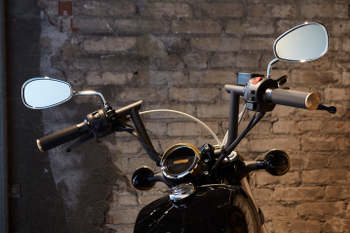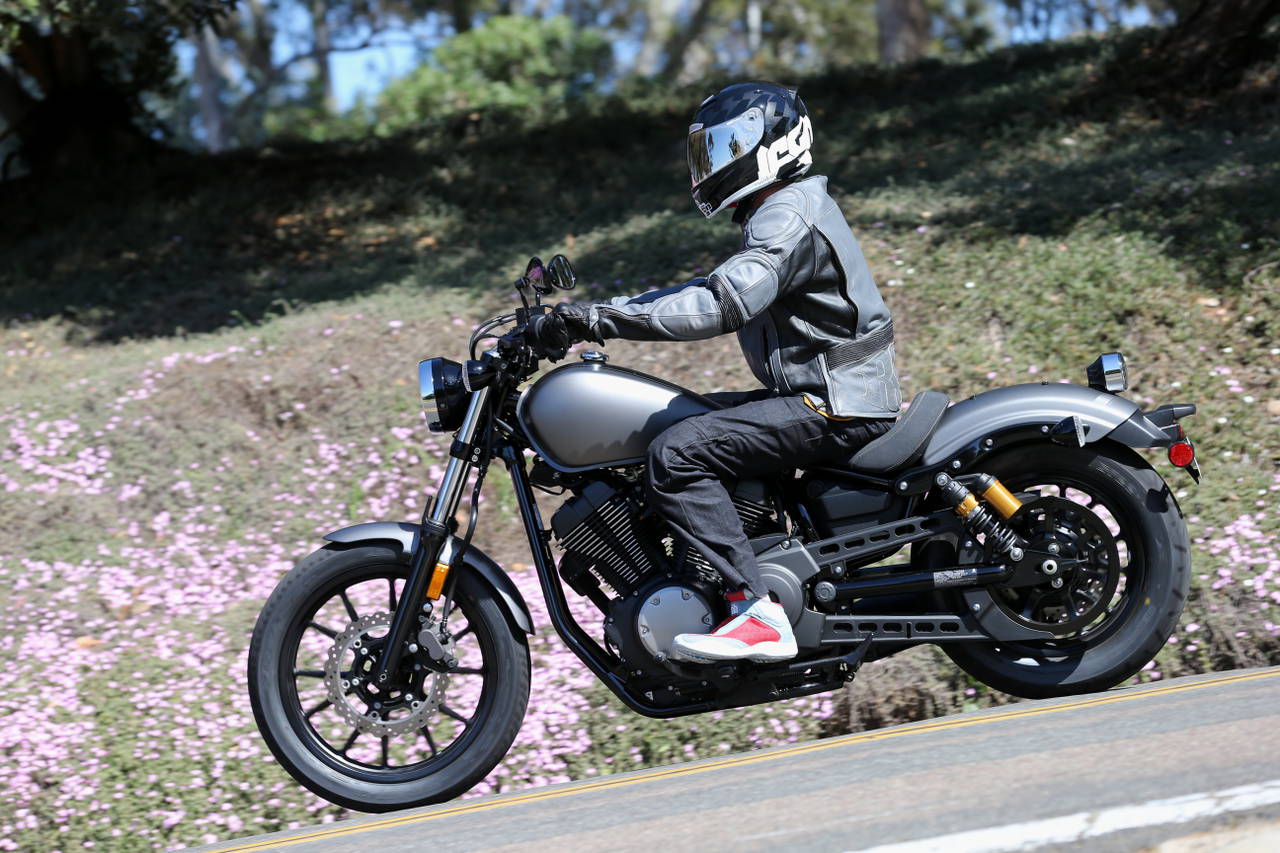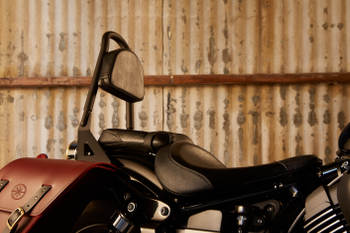

Every motorcycle begins with a goal in a designer’s mind. The goal of Star with the 2014 Bolt was to create a product that would appeal to a new generation of cruiser riders. According to Star, these younger buyers are less affluent than their Baby-boom forbears, but they’re also looking for a simpler, more stripped-down aesthetic. Hipsters, for instance (and I’m not saying Bolt buyers will be hipsters, but I’m Just Sayin’) “fetishize authenticity,” according to Time Out New York writer Christian Lorentzen (I like Cracked’s definition of Hipsters – ed.). That means younger buyers want a more authentic experience — or to at least look like they’re riding the real deal … like something they found and rebuilt themselves (while wearing Ray Ban Wayfarers – ed.).
These new buyers are anti-establishment and want to ride something that’s simple, stripped-down—but unique. “They don’t want to follow fad or fashion—they want to be their own person,” said Yamaha Product Planner Derek Brooks. Showing us slides charting Star motorcycle’s branding strategies, there were lots of XS650 photos and references, a low-slung, torquey, vibey and imperfect motorcycle that has lots of fans and has been subjected to every kind of modification you can imagine, from bobber to flat-tracker to cafe-racer and every possible interpretation in between.
A retro, big-bore, air-cooled parallel Twin was never in the cards (I asked Bolt Project Leader Ooki Miyakozawa about that, and he just looked at me blankly). Instead, the design team started with the Star 950 V-Star’s four-valve, dohc, 942cc (58 cubic inch) air-cooled 60-degree V-Twin. The bore and stroke numbers are slightly oversquare at 85mm X 83mm, and it has other performance touches, like forged aluminum pistons and ceramic cylinder liners. “We do what we can to improve performance,” according to Yamaha testing division guru Mike Ulrich. That said, there’s but one throttle body, although it does offer up two 35mm injectors, working with a Mikuni system offering 3-D ignition mapping. The catalyzed exhaust system’s headers are forward-routed, which means the big bazooka of a muffler doesn’t stick too far to the rear.
Usability is the word for the motor. The gearbox uses five straight-cut gears, and it’s worked with a “light-pull” clutch to make it attractive to new riders. A 21mm reinforced belt looks nice and sends power quietly and efficiently to the rear wheel. The valves adjust with screws on the tappets, good news for budding do-it-yourself mechanics—and they’ll get plenty of practice, with 4000-mile valve-check intervals.


The frame is all-new, but familiar-looking nonetheless. It’s a rigid tube-steel item that solid-mounts the motor. Suspension is similarly simple, but Ulrich tells us the spring and damping rates have been carefully selected to get both a “high-quality feel and get a low look”—the preload-adjustable rear shocks offer just 2.8 inches of travel. The R-Spec’s reservoir-equipped gold-anodized units don’t just look better, they have different internal damping, though the springs are the same. The non-adjustable 41mm KYB fork locates a 19-inch aluminum wheel slowed by a 298mm wave-style disc/two-piston sliding-pin caliper. The 16-inch aluminum rear wheel gets the same diameter disc and a one-pot caliper. Tires are Bridgestone Excedras, a 100/90-19 and 150/80-16.
The rest of the bike is a mix of minimalistic nostalgia and high-tech touches. The fenders are steel, the solo saddle is low and thin (just 27.2 inches off the ground to deliver “showroom confidence,” Brooks says) and there are no passenger pegs (although they’re available)(Hipsters ride alone – ed.). But there’s an LCD speedometer, LED taillight and a multi-function switch on the left switchpod to toggle through the odometers and clock.
Okay, I’ll come right out and say it, since everybody’s thinking it—the Bolt’s styling is a clear shot across Harley-Davidson’s bow, with styling clearly derivative of the 883 Iron. From the exposed frame backbone, to the engine’s hulking look and the clever plastic covers over the cylinder heads to make them look like MoCo items, Star really nailed the look…until you get to that tank, or more specifically, the huge seams around the pressed-steel tank.
Ooki-san looked sad when I pointed the seams out, but what can you do? Harley just has a different way of doing things. To create the necessary spaces between bodywork and various components and get the tank the right width to achieve that narrow, purposeful look, you’re going to have a wider seam, especially if you want to keep the price point down below $8,000. I was surprised an accessory tank isn’t available. At least it carries a useful 3.2 gallons of gas, and if you ignore the seams the bike has a very appealing, well-proportioned and balanced design that certainly grabs your attention — that’s why you’re reading this, no?
The Bolt promises an authentic riding experience (Hipsters fetishize authenticity, remember?) — and it delivers. There’s just enough lub-a-dub vibration, but the motor isn’t too buzzy until you’re breaking the law. The exhaust note is loud enough to hear at freeway speeds, and it’s got just the right roar. The rigid frame, 19-inch front wheel and short-ish 61.8-inch wheelbase offer up a mix of nimble steering and stability not unlike a nicely set-up vintage ride.

It’s engaging in a way other metric cruisers can’t manage, but it’s still easy and comfortable to ride. It’s no beginner-friendly lightweight at 540 pounds, but that’s 40 pounds lighter than an 883 and 73 pounds less than the V Star 950 from whence the motor came. And the weight is low in the frame, so you mix that with the good steering lock, narrow bars and low seat and around-town confidence is great. The brakes, simple as the specs are, work very well, and the front fork offers similar utility. The rear shocks bottom out easily, but the damping soothes the experience enough to make it less miserable than it could be, and the R-Spec dampers make it noticeably better still. The buttery-soft clutch works well with the slick-shifting gearbox—a gearbox engineered with just enough throw and resistance to feel like a vintage machine.
On the open road, the Bolt’s capabilities are limited—but it’s still pleasant to ride. The seating position is pure Sportster, with the high flat-track bar and mid-mounted pegs that put the rider into a weird, hunched-over crouch. I started to feel (and probably look) like Quasimodo after a while, but a couple hours in the saddle won’t ruin your day. The buzzing and windblast over 80 mph might, so keeping it in that sweet spot around 75 is heartily recommended, even if the bike will break into triple digits just smoothly rolling on the throttle in fifth gear.
Who’s going to buy the Bolt? Nobody who wants a Sportster, probably. But at $7,990 ($9 less than the aforementioned 883 Iron), or $8,290 for the R-Spec (which includes blacked-out mirrors and color-matched stitching on the saddle, in addition to the upgraded shocks), the Bolt is a great platform for customizing (the accessories we saw were pretty unique for a Japanese factory, including some stylish apehanger bars and brass—yes, brass!—headlight bezels) or riders who want something that while not exactly authentically cool, is arguably a cool-looking and unarguably a fun-to-ride motorcycle that gets pretty close to the bare, minimalist ethos the targeted buyers want.


No comments:
Post a Comment